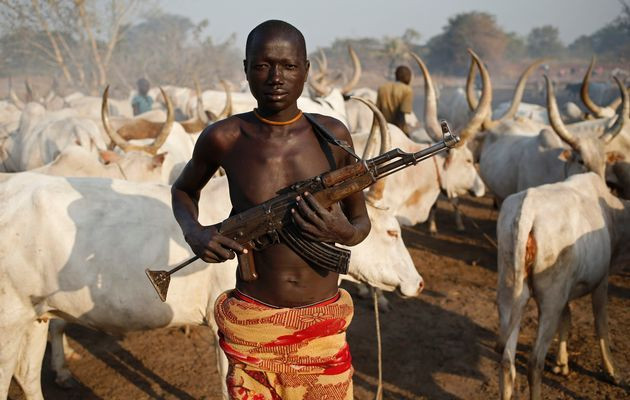With So Many AK-47 Knockoffs, Can New CEO Save State-Controlled Russian Arms Manufacturer Kalashnikov By Expanding Into India And Boosting Sales To US Gun Buyers?

“AK-47, the very best there is. When you absolutely, positively, got to kill every mother****er in the room.” – Ordell Robbie (Samuel L. Jackson) from the 1997 film “Jackie Brown.”
“Those nuclear missiles, they sit in their silos. Your AK-47, that is the real weapon of mass destruction.” – Jack Valentine (Ethan Hawke) from the 2005 film “Lord of War.”
Months before he died last December, Mikhail Kalashnikov, the Russian national hero and inventor of the legendary AK-47 machine gun that carries his name, pondered what he called the “unsolved question” of whether he bears any responsibility for the deaths caused by the world’s most proliferated and replicated weapon.
Kalashnikov died of natural causes last year at 91, leaving his quandary unresolved. Now, the future of the company named after him is also in question.
Alexei Krivoruchko, the new CEO of Kalashnikov Concern, formed last year after the merger of 206-year-old arms manufacturer Izhmash, which produces the AK-47, and firearms maker Izhevsk Mechanical Plant, says the company lost some 1.7 billion rubles in 2013. But on Tuesday, Krivoruchko outlined a two-year plan to bring Kalashnikov Concern back to profitability.
“Today Concern is still running at a loss,” he said at a press conference in Moscow. “In financial terms, the situation is difficult.”
The new CEO, one of two investors who came forward in September to buy 49 percent of Izhmash for $78 million as part of the Russian government’s efforts to find capital to consolidate its small-arms makers, said the merged company will double annual production of its small arms in an ambitious plan to quadruple revenue to $690 million by 2020.
How is Krivoruchko planning to turn around the maker of the AK series of assault rifles, Saiga semi-automatic shotguns, the SV-98 bolt action sniper rifle, and the GSh-301 30mm cannon, among other weapons?
Apart from cutting costs and increasing production, the company is also planning an expansion this year in India with a joint venture there, according to Rostec, the state-owned umbrella group founded in 2007 to consolidate the Russian small-arms industry. Rostec (aka Russian Technologies) owns 51 percent of Kalashnikov Concern, which is based in the central Russian city of Izhevsk. The company will invest $20 million to make 50,000 weapons a year in India.
The ravenous appetite for small arms in the United States, the world’s largest civilian market for weapons, is also part of the company’s growth plans. Last month the company signed an exclusive five-year supplier deal with Russian Weapon Company (RWC Group), the largest exporter of Russian small arms to North America, to supply up to 200,000 firearms for the U.S. and Canadian markets in 2014.
“The exclusive deal with RWC will ensure Kalashnikov has consistent sales of sports and hunting weapons in North America,” said Kalashnikov spokeswoman Elena Filatova, according to Russia Today.
Kalashnikov Concern currently sells its weapons to 27 countries, including the U.K., Italy, Kazakhstan and Thailand. The company’s iconic product, the AK-47, has become ubiquitous worldwide because of its reputation as a reliable killing machine. The machine gun is renowned for its simplicity, requiring little maintenance. The gun’s long-stroke piston basically ensures the weapon doesn’t jam even with lax lubrication. The simple design of the rifle makes it easy to duplicate, so counterfeit versions of the gun have flourished, driving prices down. These qualities have made the AK-47 (and its variants) the gun of choice for terrorists, insurgents and drug lords worldwide. The U.S. State Department has also been a major buyer, giving the AK-47 to Afghan security forces.
According to a 2006 report on the AK-47 by Oxfam, the international confederation of poverty-eradication groups, the gun’s ability to toss out a barrage of bullets (it can empty a 30-round clip in 3 seconds) that slow down quickly means it can severely maim people caught in the crossfire. Bullets that travel fast tend to cause “clean wounds,” compared to what slow, tumbling bullets cause.
“At excessive ranges (more than 1,000 meters), an assault rifle can still cause tremendous injuries, due to the severe wounding and maiming effects of slow-moving, unstable bullets on the human body,” said the report. “In Afghanistan, for example, the severe ‘yawing’ effect of the Kalashnikov bullet when it enters the body can be seen clearly on the streets of Kandahar, Herat and Kabul, where nonfatal wounds resulting from the turning of the round in human flesh have produced thousands of disabled people and amputees.”
A separate Oxfam briefing paper in 2007 concluded that most AK-47s in Africa were imported into the continent. “The best evidence available suggests that the vast majority – more than 95 percent – of Africa’s most commonly used conflict weapons (Kalashnikov derivatives) come from outside the continent,” the report said.
The study found that most AK-47s (and their derivatives) sent to Africa to arm combatants there come from Albania, Bulgaria, China, Germany, Hungary, India, Iraq, North Korea, Poland, Romania, Russia, Serbia and Venezuela.
© Copyright IBTimes 2025. All rights reserved.






















